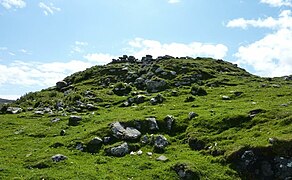Dun Cuier
Dun Cuier ( Scottish Gaelic Dun Chuidhir ) is an Iron Age dun , near the A888 road on the island of Barra , part of the Outer Hebrides .
The small, well-preserved complex on the top of a low hill was wrongly interpreted as one-period in 1956. The structure, with an inner diameter of nine meters, has now been identified as Broch or Dun , into which a cell-like house ( wheelhouse ) was later built. Dun Cuier has a five-meter-thick curtain wall, in the middle of which there is an almost completely circumferential gallery through which one could reach the no longer existing higher level. The access is in the east. A hole that held the beam that was part of the door construction can be seen on the south side of the passage. The structure itself was obviously from the first millennium BC. In use until the 8th century AD.
- Dun Cuier
Finds
A wide range of Iron Age and early medieval finds were made. The majority of the finds date between the 4th and 7th centuries AD, including pottery shards from the late and post-Wheelhouse phases. These are pieces of bone , bone needles, hand mills, metal objects and stone tools. Dun Cuier is one of several such systems (Dun Scurrival) on Barra, but most of them have not been excavated.
literature
- Ian Armit: The archeology of Skye and the Western Isles , Edinburgh. RCAHMS: E.2.1.ARM 1996
- Ian Armit: Cultural landscapes and identities: a case study in the Scottish Iron Age , Oxford. RCAHMS: E.9.GWI 1997
- EW MacKie: Timber-laced and vitrified walls in Iron Age forts: causes of vitrification . Glasgow Archaeol Journal, Vol. 1 1969
- EW MacKie: The vitrified forts of Scotland , in Harding, DW Hillforts: later prehistoric earthworks in Britain and Ireland, London (1976)
Web links
- Dun Cuier on ScotlandsPlaces (English)
Coordinates: 57 ° 0 ′ 3.1 ″ N , 7 ° 29 ′ 46.5 ″ W.



